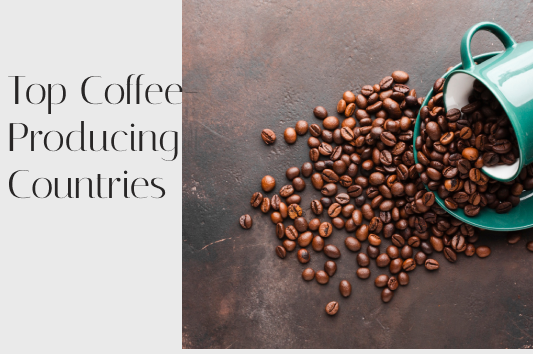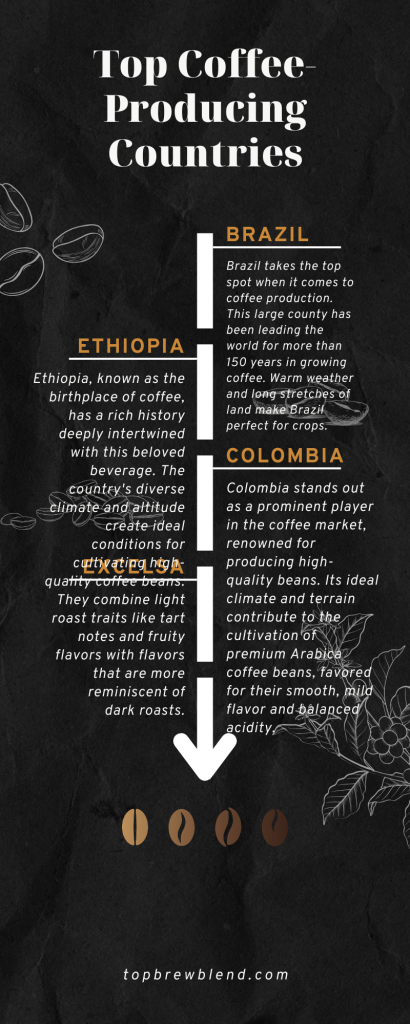What Country Makes the Best Coffee

Coffee is a popular drink that many people enjoy. It starts with beans grown in different countries around the world. Brazil has been making the most coffee for over 150 years. Ethiopia is another country famous for its coffee which can taste fruity or spicy.
Colombia’s coffee is known to be of very high quality because they have great weather for growing Arabica beans. Then there’s Indonesia, where they make strong and special types of coffee with a method called wet-hulling.
Also, Jamaica makes Blue Mountain coffee, one of the tastiest and most expensive coffees out there.
The way each place grows and makes its own kind of coffee is important too. Things like climate, land shapes, how farmers work on their farms, and how they turn beans into the coffee we drink all play a part in making each cup unique.
Different places have their own styles of enjoying and drinking coffee as well—a sign that it brings people together all across the globe.
Let’s find out more about these amazing coffees!
Top Coffee-Producing Countries
Brazil is the world’s largest producer of coffee, while Ethiopia is known as the birthplace of coffee. Colombia is renowned for its high-quality beans, and Indonesia produces unique and strong coffee.
Finally, Jamaica is famous for its Blue Mountain coffee.

Brazil: the world’s largest producer
Brazil takes the top spot when it comes to coffee production. This large county has been leading the world for more than 150 years in growing coffee. Warm weather and long stretches of land make Brazil perfect for crops.
Farmers here grow both Arabica and Robusta beans, giving us many tastes to enjoy.
Every year, Brazil makes about a third of all the coffee in the world. The beans from here go into cups all over the planet, showing how important Brazilian coffee is in global markets.
People choose these beans for their smooth taste and good quality. Coffee lovers often look for Brazilian blends because they offer a balance of sweetness and body that’s hard to beat.

Ethiopia: the birthplace of coffee
Ethiopia, known as the birthplace of coffee, has a rich history deeply intertwined with this beloved beverage. The country’s diverse climate and altitude create ideal conditions for cultivating high-quality coffee beans.
Ethiopian coffee is famous for its unique flavors, ranging from fruity and floral to earthy and spicy, offering a wide range of taste profiles for coffee enthusiasts to explore. Coffee farming in Ethiopia often follows traditional methods, with many smallholder farmers handpicking the ripe cherries to ensure the best quality.
This careful attention to detail results in some of the most sought-after coffees globally, making Ethiopia a prominent player in the global coffee market.
Colombia: known for its high-quality beans
Colombia stands out as a prominent player in the coffee market, renowned for producing high-quality beans. Its ideal climate and terrain contribute to the cultivation of premium Arabica coffee beans, favored for their smooth, mild flavor and balanced acidity.
Colombia’s distinctive coffee- growing regions, including Medellin and Armenia, are celebrated for consistently delivering top-grade beans sought after by discerning consumers globally.
The nation’s dedication to sustainable farming practices further enhances the appeal of its coffee products, reflecting a commitment to quality and environmental responsibility.
Indonesia: produces unique and strong coffee
Indonesia stands out as a top coffee-producing country, renowned for its distinct and potent coffee. The combination of ideal climate and fertile volcanic soil in regions like Sumatra and Java result in the growth of unique varieties like Sumatran Mandheling and Sulawesi Toraja.
These coffees are characterized by earthy flavors, low acidity, full body, and rich aroma, making them highly sought after in the global coffee market.
The strong taste profile of Indonesian coffee can be attributed to the wet-hulling process used during production. This method enhances the beans’ flavor by imparting a deep richness and complexity to the final brew.
Jamaica: famous for its Blue Mountain coffee
Jamaica is renowned for its Blue Mountain coffee, which is grown in the cool and misty Blue Mountains. The unique climate and rich soil of this region contribute to the exceptional flavor profile of the coffee beans.
Jamaica’s strict regulations on the cultivation and processing of Blue Mountain coffee ensure that only the highest quality beans reach the market, making it one of the most sought-after and expensive coffees globally.
Its mild yet complex flavor with a hint of sweetness makes it a favorite among coffee connoisseurs.
| Country | Key Features |
|---|---|
| Brazil | – World’s largest coffee producer |
| – Leading for over 150 years | |
| – Ideal conditions: Warm weather, vast land | |
| – Grows Arabica and Robusta beans | |
| – Produces about a third of global coffee | |
| – Smooth taste, high quality, popular globally | |
| Ethiopia | – Birthplace of coffee |
| – Diverse climate, altitude ideal for coffee | |
| – Rich history, deep connection to coffee | |
| – Unique flavors: fruity, floral, earthy, spicy | |
| – Traditional farming methods, handpicking | |
| – Sought-after globally for quality | |
| Colombia | – Renowned for high-quality Arabica beans |
| – Ideal climate and terrain for coffee | |
| – Distinctive regions: Medellin, Armenia | |
| – Smooth, mild flavor, balanced acidity | |
| – Dedication to sustainable farming practices | |
| – Top-grade beans sought globally | |
| Indonesia | – Unique and strong coffee producer |
| – Ideal climate, fertile volcanic soil | |
| – Regions: Sumatra, Java | |
| – Unique varieties: Sumatran Mandheling, Sulawesi Toraja | |
| – Earthy flavors, low acidity, full body | |
| – Rich aroma, highly sought after globally | |
| – Wet-hulling process enhances flavor complexity |
What Factors Affecting Coffee Production
Climate and geography play a crucial role in coffee production, influencing the flavor and quality of the beans. Additionally, farming practices and production methods also impact the final product.

Climate and geography
Different countries have different climates and geography, which play a crucial role in coffee production. The ideal conditions for growing coffee include tropical or subtropical climates with abundant rainfall and well-drained soil.
Countries near the equator, such as Brazil, Ethiopia, Colombia, and Indonesia, provide the perfect environment for coffee cultivation. The altitude at which coffee is grown also impacts its flavor profile; higher altitudes generally produce more acidic and flavorful beans.
Additionally, factors like temperature fluctuations and seasonal variations in rainfall affect the quality of the coffee beans. In some regions, such as Jamaica’s Blue Mountain region, the unique combination of climate and terrain results in highly sought-after specialty coffees known for their exceptional flavor characteristics.
Farming practices
Different countries have varied farming practices that affect the quality and flavor of their coffee beans. Brazil, known for its mass production, often uses mechanized farming techniques to harvest its coffee beans quickly.
In contrast, Ethiopia still relies on traditional methods where much of the work is done by hand. Colombia focuses on sustainable and environmentally friendly practices, while Indonesia’s volcanic soil contributes to its unique and strong coffee flavors.
Jamaica, with its Blue Mountain coffee, follows strict regulations to maintain high-quality standards.
The farming practices in these countries play a significant role in determining the taste and characteristics of the coffee produced. Climate and geography also influence the cultivation methods employed by each country.
Production methods
Coffee production methods vary from country to country, impacting the flavor and quality of the beans. In Brazil, the world’s largest coffee producer, much of the coffee is harvested using mechanical strippers or pickers.
Meanwhile, in Ethiopia, where coffee originated, many farms still rely on traditional hand-picking methods. The processing methods also differ; some countries use dry processing while others prefer wet processing to remove the cherry pulp from the bean.
In Colombia, high-quality beans are often handpicked and meticulously processed to ensure consistency and excellence. Indonesian coffee stands out due to its unique “giling basah” method that produces a strong and earthy flavor profile.
Quality of Coffee from Different Countries
Each country produces coffee with unique taste profiles and varieties, influenced by their climate and geography. Understanding the differences in coffee quality from different regions can help coffee enthusiasts explore and appreciate the diversity of flavors available.
Taste profiles of various regions
Brazilian coffee is known for its smooth, nutty flavor with a hint of chocolate. Ethiopian coffee offers a diverse range of tastes, from fruity and wine-like to floral and tea-like.
Colombian coffee is characterized by its mild acidity, medium body, and sweet, citrusy undertones. Indonesian coffee boasts earthy, herbal notes with a distinct syrupy body. Jamaican Blue Mountain coffee is celebrated for its mild flavor, bright acidity, and unique balance.
In Brazil’s warm climate and rich soil contribute to the beans’ low acidity and full-bodied richness. Ethiopia’s high elevation produces beans with vibrant flavors due to cooler temperatures which slow down the maturation process.
Types of coffee varieties grown
Coffee varieties vary widely depending on the region where they are grown. Some popular types include Arabica, known for its smooth and flavorful profile, often cultivated in countries like Brazil and Colombia.
Another variety is Robusta, famous for its strong and bold taste, commonly found in regions such as Indonesia and Vietnam. Other common coffee varieties include Liberica, prized for its unique flavor with a fruity twist, mainly grown in the Philippines; and Excelsa known for its complex taste with hints of fruit and spice, primarily produced in Southeast Asia.
These different coffee varieties offer a wide range of flavors and profiles that appeal to various preferences globally. Factors such as climate conditions, altitude, soil quality play a significant role in shaping these diverse coffee profiles across different countries.
Coffee Culture and Consumption in Different Countries
Coffee culture varies greatly from country to country, with some cultures emphasizing the social aspect of coffee consumption while others focus on the rituals of brewing and serving.
The trends in coffee consumption also differ, with some countries preferring traditional methods while others embrace specialty drinks and innovative brewing techniques.
Global coffee culture
Coffee culture varies around the world, with each country having its unique way of enjoying this beloved beverage. In some places, like Italy and France, coffee is a significant part of socializing; people chat in cozy cafes over tiny cups of strong espresso.
Meanwhile, in countries like Ethiopia and Turkey, coffee ceremonies are deeply rooted in tradition, symbolizing hospitality and community. Furthermore, in Australia and New Zealand, there’s a prevalent love for artisanal coffee and creative brewing methods.
In Japan, precision and attention to detail define their meticulous approach to making pour-over coffee an art form.
Moreover, as global travel becomes more accessible, so does the sharing of different coffee cultures. This has led to an increased appreciation for diverse brewing techniques and flavor profiles worldwide.
Trends in coffee consumption
As coffee culture continues to evolve, so do trends in coffee consumption. With the rise of specialty coffee shops and artisanal roasters, consumers are becoming more discerning about their coffee choices.
Single-origin beans, unique brewing methods such as pour-over and cold brew, and sustainable practices are gaining popularity among coffee enthusiasts. Additionally, flavored and functional coffees like pumpkin spice or nitro cold brew are capturing a larger market share as consumers seek diverse experiences.
In response to changing consumer preferences, the industry is witnessing an increase in ready-to-drink options, from canned lattes to bottled cold brews. Moreover, there’s a growing demand for ethically-sourced and fair trade coffee as consumers become increasingly aware of the social and environmental impact of their purchases.
Conclusion
In conclusion, the top coffee-producing countries have unique tastes and qualities. Understanding factors such as climate, farming practices, and production methods can impact the quality of coffee from different regions.
Exploring global coffee culture and consumption in various countries provides insights into diverse brewing traditions and trends. By appreciating these differences, coffee enthusiasts can enhance their enjoyment of this beloved beverage.
The rich history and variety of coffees worldwide offer an exciting journey for anyone passionate about discovering new flavors.

